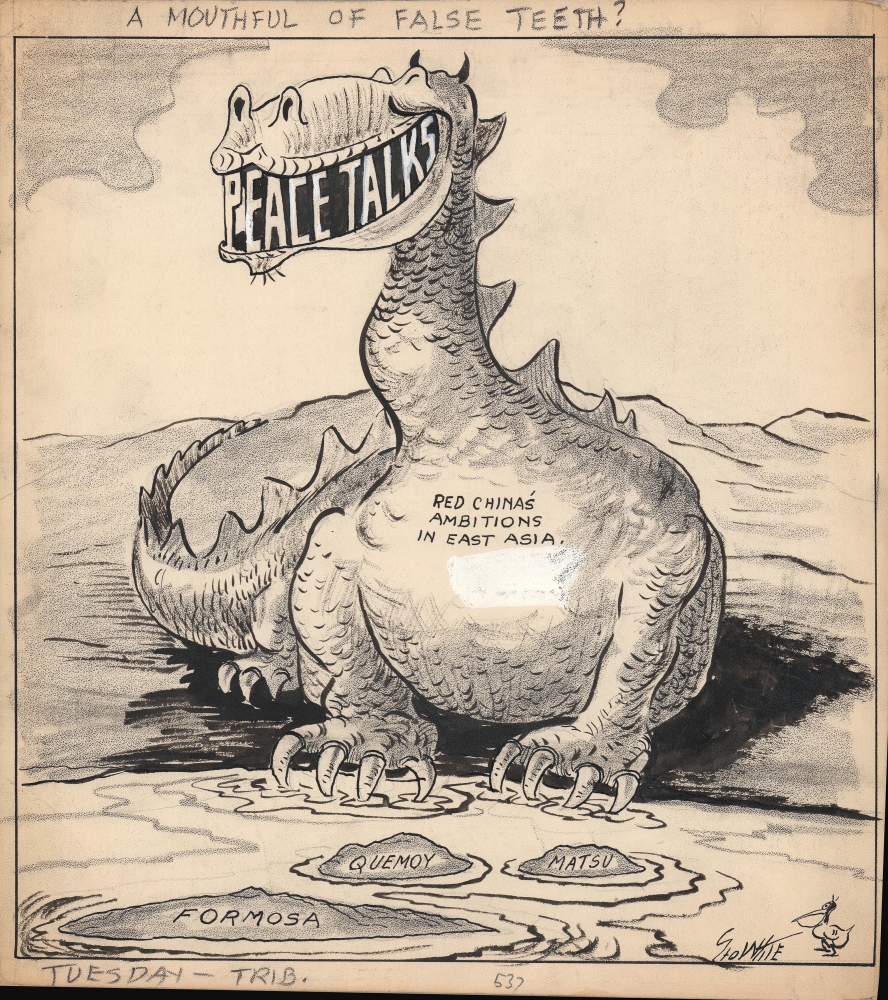1955 White Cartoon Original Art, Chinese Civil War, Taiwan (Formosa)
Formosa-white-1955
Title
1955 (undated) 11 x 10 in (27.94 x 25.4 cm)
Description
A Closer Look
Facing towards the west, the cartoon depicts Formosa (Taiwan) and the islands of Matsu (Mazu) and Quemoy (Kinmen / Jinmen) in the foreground, with the Chinese mainland in the background. A large dragon representing the People's Republic of China (P.R.C.) flashes a smile with the words 'Peace Talks,' the implication being that these overtures were insincere, and that 'Red China' remained an expansionist power dedicated to seizing Taiwan and exporting revolution.The First Taiwan Straits Crisis
The First Taiwan Straits Crisis ranged over several months in late 1954 - early 1955, and were the result of broader tensions between the U.S. and the P.R.C. The two countries had fought each other as the major foreign powers involved in the Korean War, which had only recently been paused by an armistice in July 1953. The Chinese Civil War that had resulted in the expulsion of the anti-Communist Nationalist Party (Guomindang) to Taiwan was still ongoing, with skirmishes around the borders of the People's Republic, including in the Taiwan Straits, and both sides were committed to 'reunifying' the country under their banner.To stabilize the situation, the U.S. 7th Fleet 'closed' the Taiwan Straits after the start of the Korean War - preventing a P.R.C. invasion of Taiwan and vice versa. But by 1953 the situation had changed, with a new administration in the White House and growing concerns about Communist expansion. U.S. restrictions were lifted and in August 1954 the R.O.C. placed tens of thousands of troops on islands just off the coast of the mainland, most importantly Matsu and Quemoy. In response, the People's Liberation Army shelled and bombed the islands. Tensions continued to increase, with the U.S. openly mulling the use of nuclear weapons in the case of an invasion of Taiwan and moving towards a mutual defense treaty with the Republic of China.
The P.R.C. did manage to capture the Yijiangshan and Dachen Islands, but ultimately quietly backed down in the face of increasing U.S. threats of a nuclear strike and offered to negotiate, referred to in the cartoon above. Soon afterwards, China began investing heavily in its own domestic nuclear weapons program, which succeeded in testing a nuclear weapon in 1964.
A Second Taiwan Straits Crisis saw renewed fighting in the closing months of 1958. Afterwards, the Sino-Soviet Split, the tumultuous domestic politics of the P.R.C., and Sino-American rapprochement led to a stabilized situation in the Taiwan Straits. This situation was upset in the Third Taiwan Straits Crisis in 1995 - 1996, where the P.R.C. aimed to deter any declaration of independence by a now-democratic Republic of China. In recent years, tensions in the Taiwan Straits have increased again, with Taiwanese feeling less and less interested in a political union with the mainland, and the P.R.C. making the 'reunification' of China a central pillar of the 'great rejuvenation of the Chinese nation,' a favored political slogan of Xi Jinping.
Publication History and Census
This is the original manuscript draft of George White's cartoon for the Tampa Morning Tribune, most likely in April 1955.Cartographer
George White (1901 - March 7, 1964) was born in Grand Rapids, Michigan and relocated to Tampa with this family in 1915. White studied art under Tampa artist Walter Collins and began work as a commercial artist at the Tampa Morning Tribune in 1928 and by 1934 was a regular cartoonist at the Tribune. Rather unconventionally, the paper featured his cartoons on the front page. His work displays the evolving course of America's domestic and geopolitics from the interwar period, through the Second World War, and into the Cold War More by this mapmaker...

